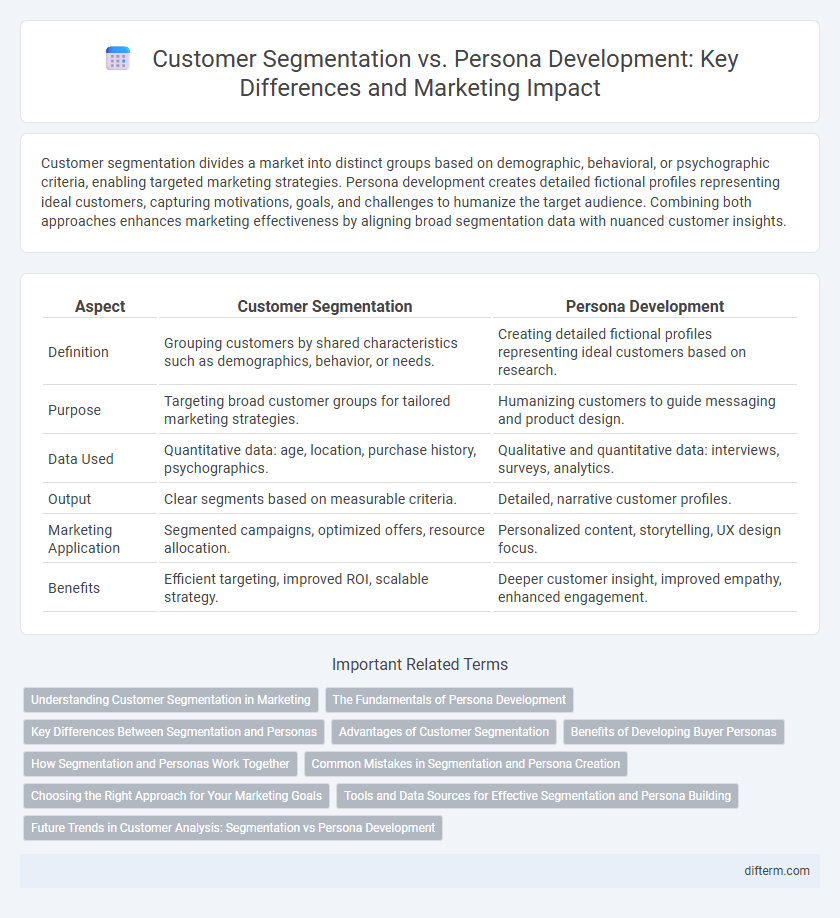Customer segmentation divides a market into distinct groups based on demographic, behavioral, or psychographic criteria, enabling targeted marketing strategies. Persona development creates detailed fictional profiles representing ideal customers, capturing motivations, goals, and challenges to humanize the target audience. Combining both approaches enhances marketing effectiveness by aligning broad segmentation data with nuanced customer insights.
Table of Comparison
| Aspect | Customer Segmentation | Persona Development |
|---|---|---|
| Definition | Grouping customers by shared characteristics such as demographics, behavior, or needs. | Creating detailed fictional profiles representing ideal customers based on research. |
| Purpose | Targeting broad customer groups for tailored marketing strategies. | Humanizing customers to guide messaging and product design. |
| Data Used | Quantitative data: age, location, purchase history, psychographics. | Qualitative and quantitative data: interviews, surveys, analytics. |
| Output | Clear segments based on measurable criteria. | Detailed, narrative customer profiles. |
| Marketing Application | Segmented campaigns, optimized offers, resource allocation. | Personalized content, storytelling, UX design focus. |
| Benefits | Efficient targeting, improved ROI, scalable strategy. | Deeper customer insight, improved empathy, enhanced engagement. |
Understanding Customer Segmentation in Marketing
Customer segmentation in marketing involves dividing a broad target market into smaller, more defined groups based on shared characteristics such as demographics, behavior, or psychographics. This approach allows businesses to tailor marketing strategies and product offerings to meet the specific needs of each segment, enhancing campaign effectiveness and customer engagement. Understanding customer segmentation provides valuable insights that drive personalized marketing, optimize resource allocation, and improve overall customer satisfaction.
The Fundamentals of Persona Development
Persona development centers on creating detailed, semi-fictional representations of ideal customers based on demographic, psychographic, and behavioral data. It requires deep analysis of customer motivations, pain points, and preferences to tailor marketing strategies effectively. Well-crafted personas enable more personalized messaging, improving customer engagement and conversion rates compared to broad customer segmentation approaches.
Key Differences Between Segmentation and Personas
Customer segmentation divides a market into distinct groups based on demographics, behavior, or psychographics, enabling targeted marketing strategies tailored to each segment's characteristics. Persona development creates detailed, fictional profiles representing ideal customers, incorporating motivations, goals, and pain points for deeper empathy and personalized messaging. While segmentation focuses on categorizing broad audiences for strategic allocation, personas emphasize narrative-driven, humanized depictions to refine content and engagement tactics.
Advantages of Customer Segmentation
Customer segmentation enables marketers to categorize audiences based on demographics, behavior, and purchasing patterns, allowing for highly targeted campaigns that improve conversion rates. This approach facilitates personalized marketing strategies by identifying specific needs and preferences within each segment, increasing customer engagement and loyalty. It also optimizes resource allocation by focusing efforts on high-value groups, enhancing return on investment compared to broad, generalized targeting methods.
Benefits of Developing Buyer Personas
Developing buyer personas enables marketers to tailor messaging and campaigns precisely, enhancing engagement and conversion rates. It provides deep insights into customer behavior, preferences, and pain points, allowing for more effective product positioning and targeted marketing strategies. Leveraging buyer personas reduces marketing waste by focusing resources on high-value segments most likely to convert.
How Segmentation and Personas Work Together
Customer segmentation divides a market into distinct groups based on demographic, behavioral, and psychographic data to tailor marketing strategies effectively. Persona development builds detailed, fictional profiles representing these segments, enabling personalized communication and product positioning. Together, segmentation provides the quantitative foundation while personas add qualitative depth, fostering targeted campaigns that resonate with specific customer needs and motivations.
Common Mistakes in Segmentation and Persona Creation
Common mistakes in customer segmentation include relying solely on basic demographics without integrating behavioral data or psychographics, leading to overly broad or inaccurate segments. In persona development, a frequent error is creating overly idealized or generic personas that lack specificity and actionable insights, which diminishes their usefulness in targeted marketing strategies. Both processes often suffer from insufficient data validation and failure to update profiles regularly, resulting in outdated or irrelevant customer understanding.
Choosing the Right Approach for Your Marketing Goals
Customer segmentation categorizes audiences based on measurable data such as demographics, purchasing behavior, and psychographics to tailor marketing strategies effectively. Persona development goes deeper by crafting detailed, fictional profiles that embody specific customer types, enabling personalized messaging and emotional connection. Selecting the right approach depends on marketing goals: use segmentation for broad targeting and performance metrics, while personas are ideal for nuanced storytelling and relationship building.
Tools and Data Sources for Effective Segmentation and Persona Building
Customer segmentation relies heavily on data analytics tools such as CRM software, Google Analytics, and advanced data mining platforms to categorize customers based on demographics, behavior, and purchase history. Persona development incorporates qualitative data from interviews, surveys, and ethnographic research combined with segmentation insights to create detailed, human-centric profiles representing target audience segments. Leveraging machine learning algorithms on big data sets enhances both segmentation accuracy and persona relevance, driving more personalized and effective marketing strategies.
Future Trends in Customer Analysis: Segmentation vs Persona Development
Customer segmentation will increasingly leverage AI-driven data analytics to create dynamic groups based on real-time behavior and preferences, enabling highly personalized marketing strategies. Persona development is evolving through the integration of predictive modeling and psychographic insights, allowing brands to craft more nuanced and emotionally resonant customer profiles. Future trends emphasize blending segmentation and persona techniques to optimize targeting precision and enhance overall customer engagement.
Customer Segmentation vs Persona Development Infographic

 difterm.com
difterm.com